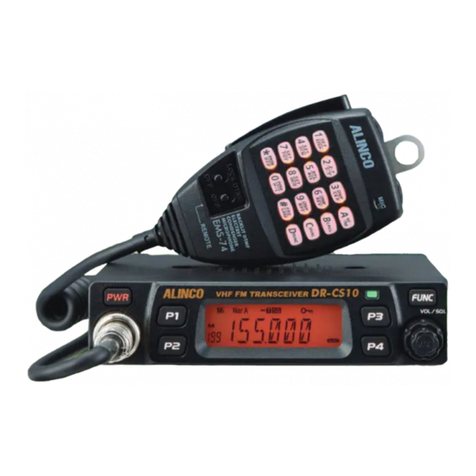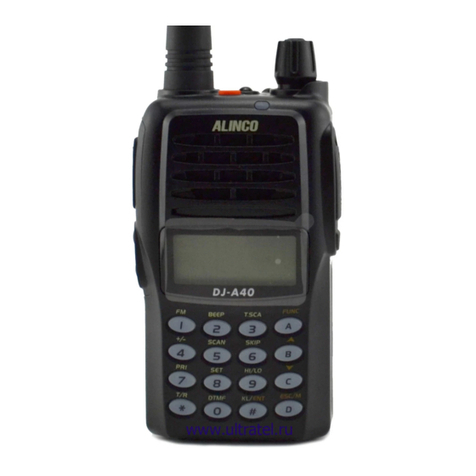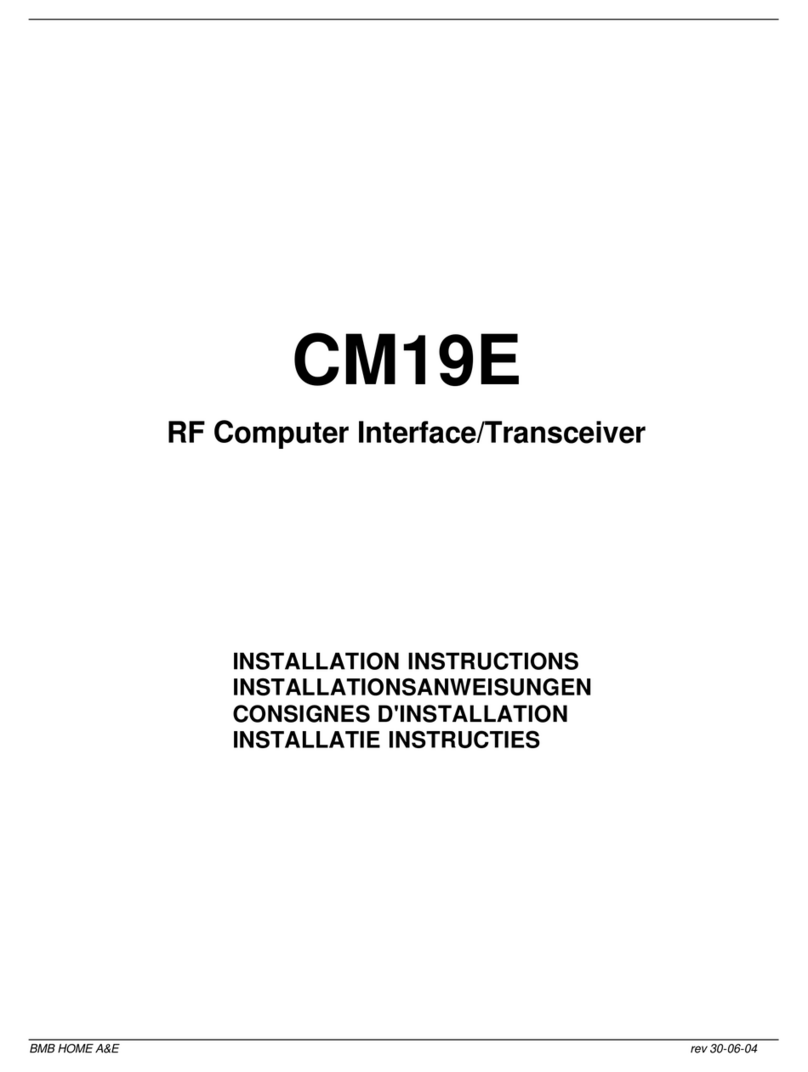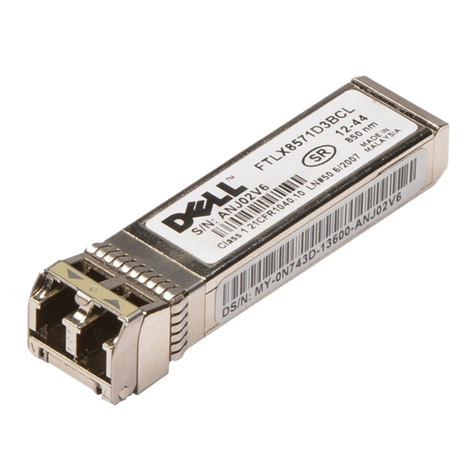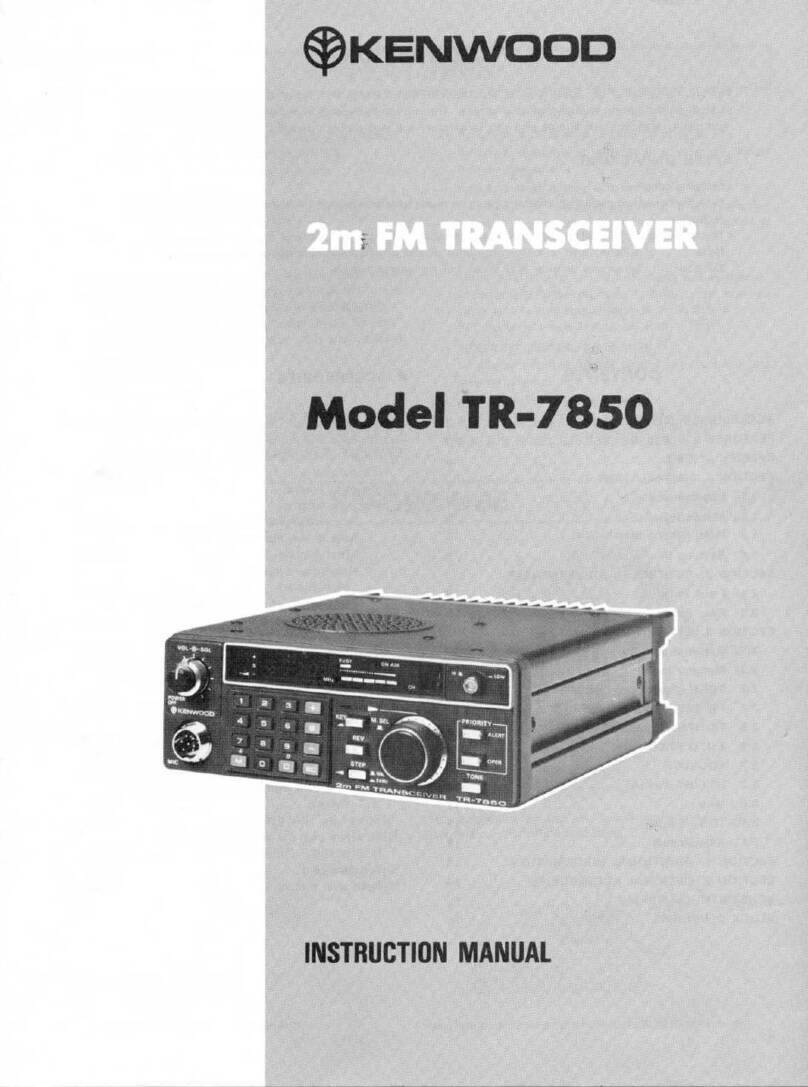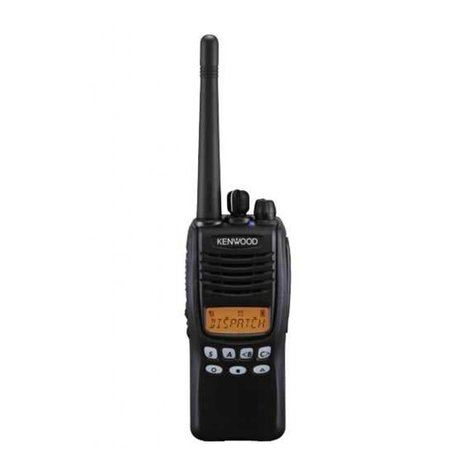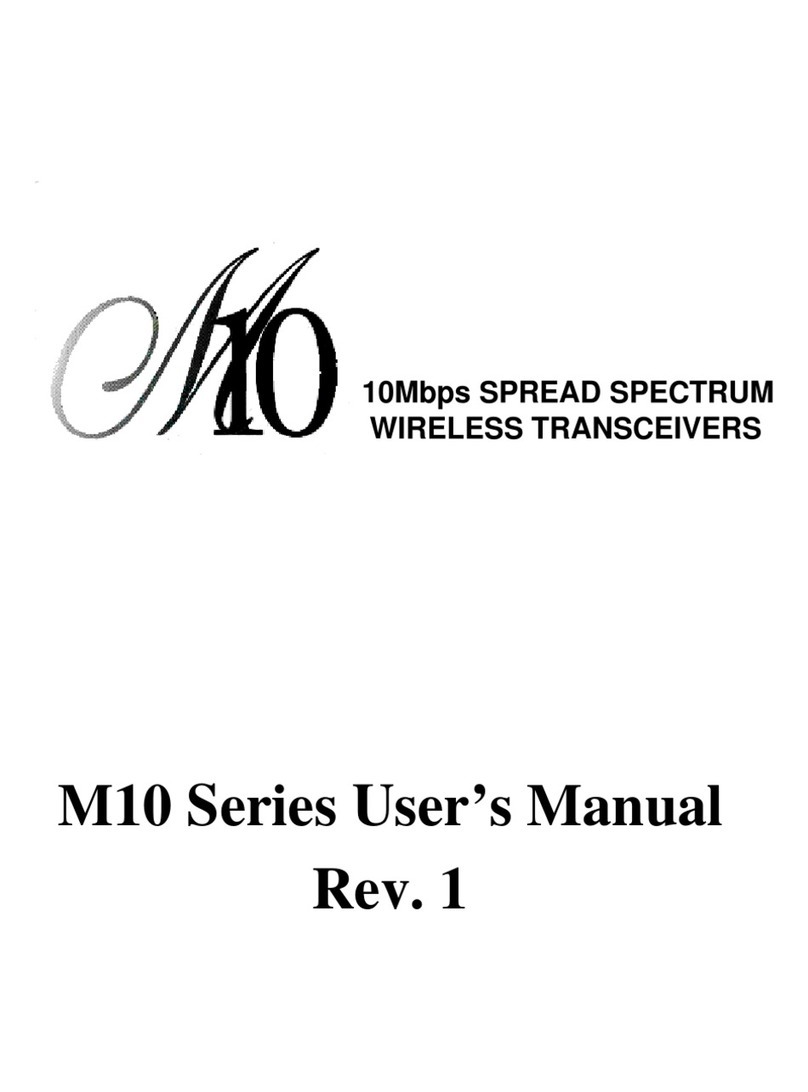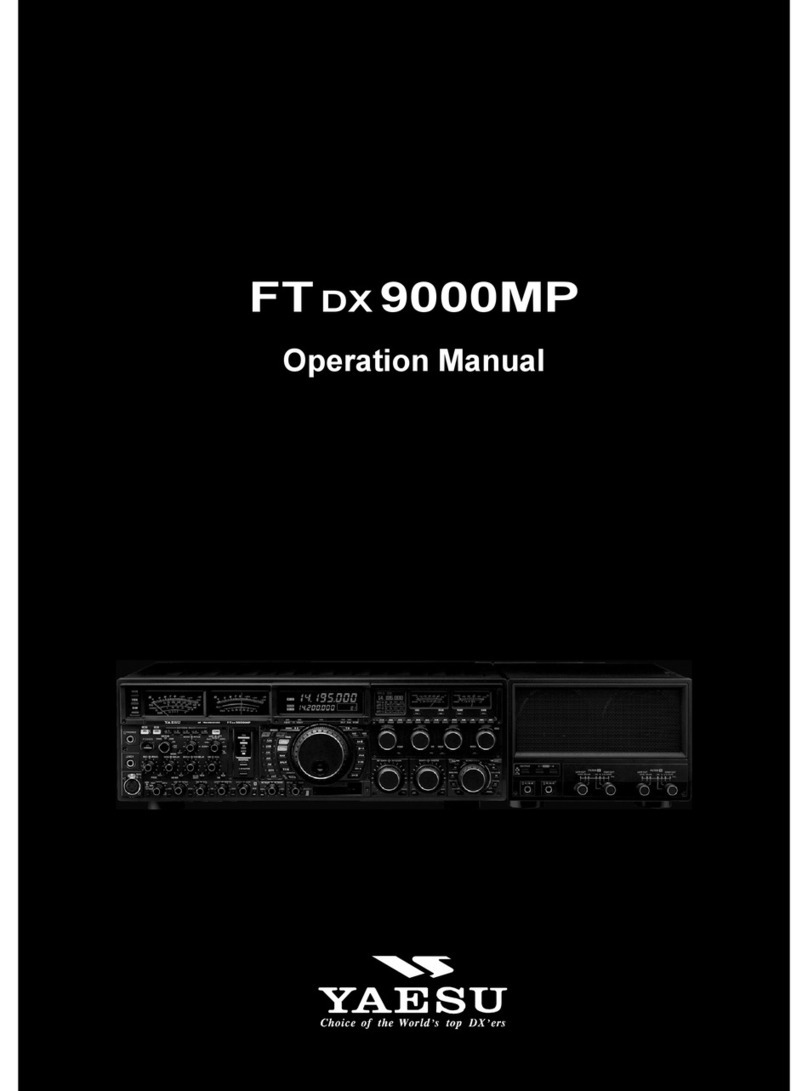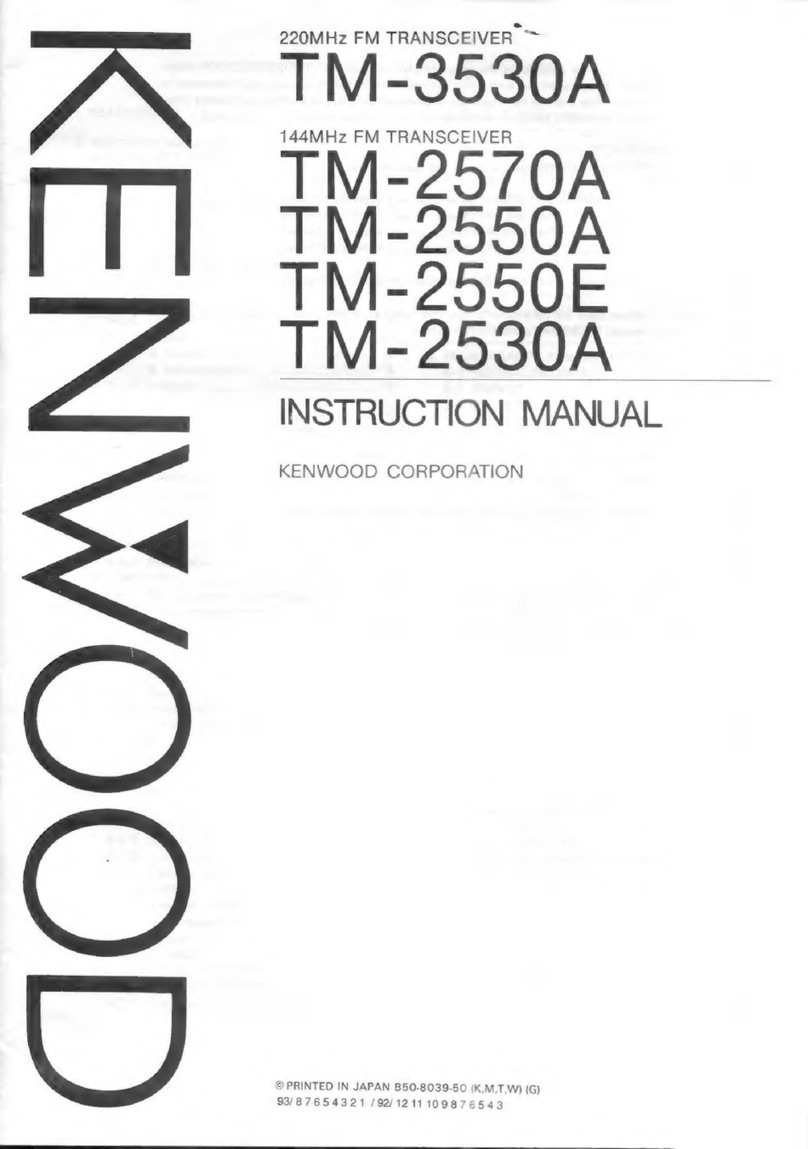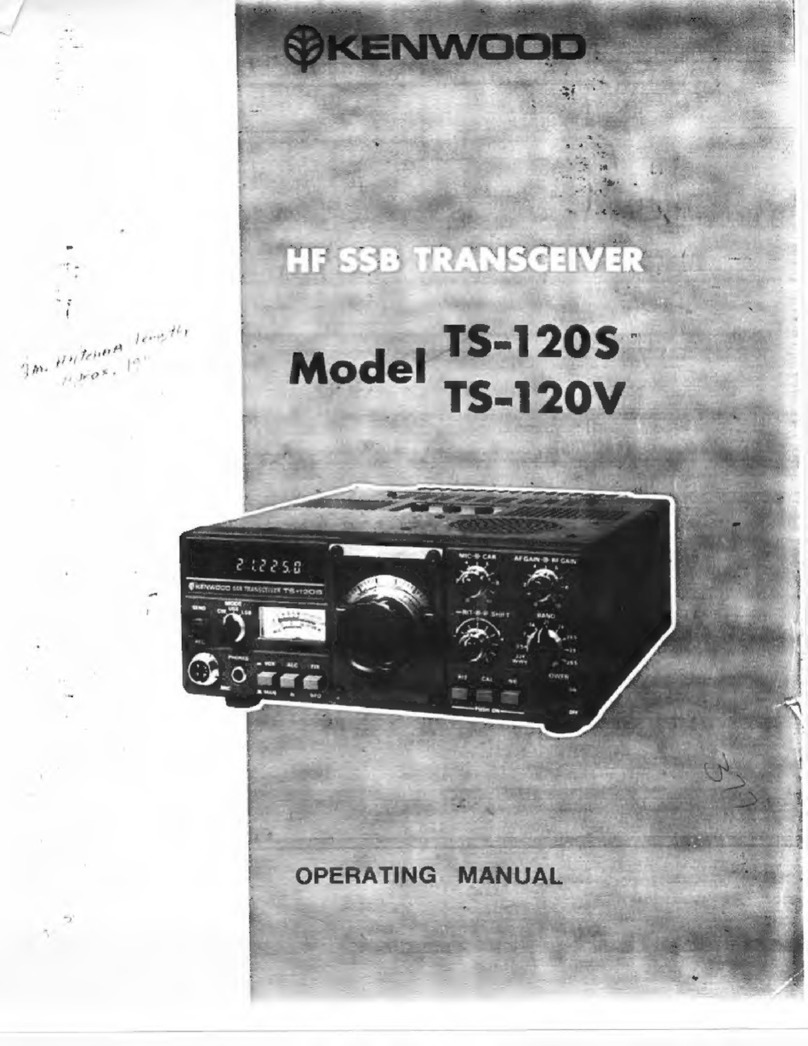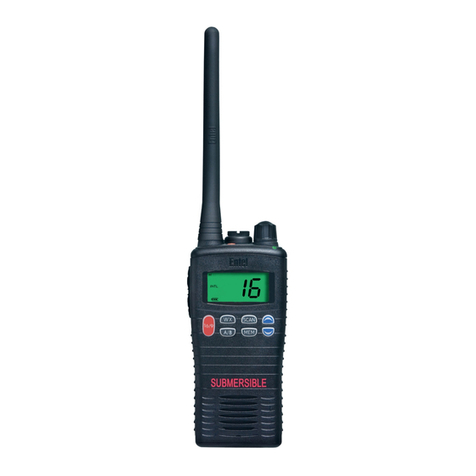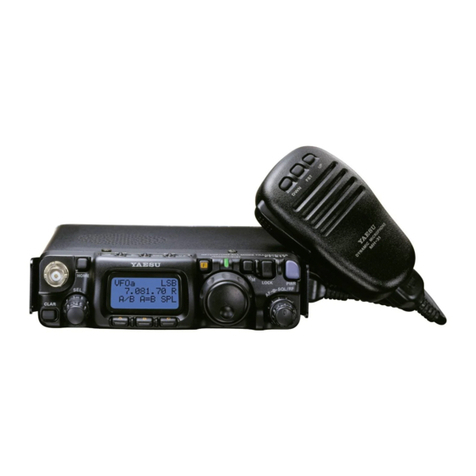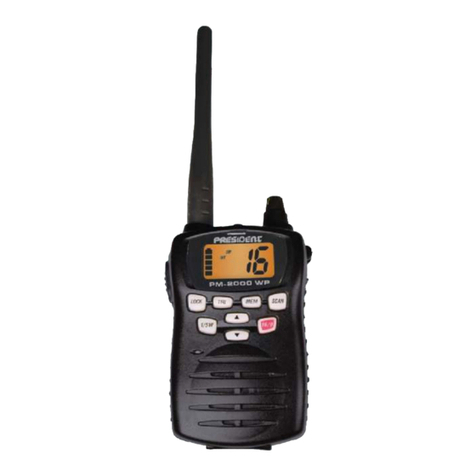Alinco DJ-191 User manual

DJ- 1 9 1
Service Manual
CONTENTS
•SPECIFICATIONS..........................................................2
•CIRCUIT DESCRIPTION...............................................3
•SEMICONDUCTOR DATA...........................................9
•EXPLODED VIEW
..................................................
15
•PARTS LIST..................................................... 18
•ADJUSTMENT..............................................................21
•P C BOARD VIEW
.............
..........................................2
•CIRCUIT DIAGRAM......................................................41
•BLOCK DIAGRAM 45

SFECIRCATIONS
144Q0O^?ł 995MHz 135 000^ 173-995MHZ
DJ-191E (EuropeanArateur versior) 144000 14® 9£NVz 144 000 — 145 995MHz
DJ-191TA1 (CoomerdaiversonVHR.) 135 000 1550QDNHz 135 000 .173095MHz
DJ-191 TA2(Connmerciai version VHFH) 150000 47399&Л4 135 000 1-73095MHz
Channel Step-. 5 1012515 2) 25,30kHz steps
Memory Channels: 40 Ch annfes4C IteCh anriiè/l emory
Antenna Impédance:
Frequency Stability: 500 unbalanced
± 5 ppm
Microphone Input Impédance: 2k0 nominal.
Signal Type:
Offset Range:
Deviation:
TX Output (supply voltage):
RX Sensitivity:
RX Selectivity:
I.F.:
Power Supply Requirements:
Current Consumption
at 13.8V DC:
Operating Température:
Dimensions:
(with EBP-37N without projections)
Weight:
DTMF:
Subaudible Tones (CTCSS):
F3E (FM)
0 ~ 99.995MHz
± 5kHz max.
1.5W (4.8V) / 3.5W (7.2V) / 5W (9. ~ 13.8V)
12dB SINAD better than - 1 dBц
- dB / ± 12kHz
(Ist) 21.25MHz / (2nd) 450kHz
4.8 ~ 13.8V DC (4.8V DC Standard)
Transmitting: Approx. 1.2 Amp. in High Power
Setting
Receiving: Squelched Approx. 24mA (BS on)
-1 0 ~ + 0°C , 14~140°F
57(W) x 151 (H) x 28(D) mm
21/4(W) x (H) x 1 Vie(D) inches
Approx. 300g
1 Button Keypad, encoder/decoder installed
Encoder installed (50 tones)

CIRCUIT DESCRIPTION
1) Receiver System
1. Front End
2. IF Circuit
3. Demodulator Circuit
4. Audio Circuit
The recei er system is a double superheterodyne system with a 21.7 MHz
first IF and a 450 kHz second IF.
The recei ed signal at any frequency in the 130.00- to 173.995-MHz range
is passed through the low-pass filter (L102, L103, L104, C113, C107, C116,
and C114) and tuning circuit (L112 and D107), and amplified by the RF
amplifier (Q107). The signal from Q107 is then passed through the tuning
circuit (L109, L110, L111, and Varicaps D104, D105 and D106) and
con erted into 21.7 MHz by the mixer (Q106). The tuning circuit, which
consists of L112, L109, Varicaps D107 and D104, L110, L111, Varicaps
D105 and D106, is controlled by the tracking oltage from the CPU so that
it is optimized for the réception frequency. The local signal from the VCO is
passed through the buffer (Q108), and supplied to the source of the mixer
(Q106). The radio uses the lower side of the superheterodyne system.
The mixer mixes the recei ed signal with the local signal to obtain the sum
of and différence between them. The crystal filter (XF101, XF102) selects
21.7 MHz frequency from the results and éliminâtes the signais of the
unwanted frequencies. The first IF amplifier (Q105) then amplifies the
signal of the selected frequency.
After the signal is amplified by the first IF amplifier (Q105), it is input to pin
16 of the demodulator IC (IC104). The second local signal of 21.25 MHz
(shared with PLL IC référencé oscillation), which is oscillated by the internal
oscillation circuit in IC102 and crystal (X101), is input through pin 1 of
IC104. Then, these two signais are mixed by the internal mixer in IC104
and the result is con erted into the second IF signal with a frequency of 450
kHz. The second IF signal is output from pin 3 of IC104 to the ceramic filter
(FL101), where the unwanted frequency band of that signal is eliminated,
and the resulting signal is sent back to the IC104 through pins 5 and 7.
The second IF signal input ia pin 7 is demodulated by the internal limiter
amplifier and quadrature détection circuit in IC104, and output as an audio
signal through pin 9.
The audio signal from pin 9 of IC104 is compensated to the audio
frequency characteristics in the de-emphasis circuit (R162, R161, C172,
C173) and amplified by the AF amplifier (Q109). The signal is then input to
pin 2 of the electronic olume (IC103) for olume adjustment, and output
from pin 1. The adjusted signal is sent to the audio power amplifier (IC105)
through pin 2 to dri e the speaker.

5. Squelch Circuit Part of the audio signal from pin 9 of IC104 is amplified by the noise filter
amplifier consisting of R176, R186, R177, C179, C183, C191, and C194,
b
and the internai noise amplifier in IC104. The desired noise of the signal is
output through pin 11 of IC104, to be further amplified by the noise amplifier
(Q115). The amplified noise signal is rectified by oltage doubler D109 and
input to pin 4 of CPU (IC5).
2) Transmitter System The audio signal is con erted to an electric signal in either the internai or
external microphone, and input to the microphone amplifier (IC6). IC6
consiste of two operational amplifiers; one amplifier (pins 1, 2, and 3) is
composed of pre-emphasis and IDC circuits and the other (pins 5,6, and 7)
is composed of a splatter filter. The maximum frequency dé iation is
obtained by VR2 and input to the cathode of the aricap of the VCO, to
change the electric capacity in the oscillation circuit. This produces the
frequency modulation.
The transmitted signal is oscillated by the VCO, amplified by the pre-dri e
amplifier (Q102) and dri e amplifier (Q101), and input to the power module
(IC101). The signal is then amplified by the power module (IC101) and led
to the antenna switch (D101) and low-pass filter (L102, L103, L104, C113,
C107, C116, and C114), where unwanted high harmonie wa es are
reduced as needed, and the resulting signal is supplied to the antenna.
3. APC Circuit Part of the transmission power from the low-pass filter is detected by D103,
con erted to DC, and then amplified by a differential amplifier. The output
oltage Controls the bias oltage from pin 2 of the power module (IC101) to
maintain the transmission power constant.
3) PLL Synthesizer Circuit
1. PLL The di iding ratio is obtained by sending data from the CPU (IC5) to pin 2
and sending dock puises to pin 3 of the PLL IC (IC102). The oscillated
signal from the VCO is amplified by the buffer (Q117) and input to pin 6 of
IC102. Each programmable di ider in IC102 di ides the frequency of the
input signal by N according to the frequency data, to generate a
comparison frequency of 5 or 6.25 kHz.
2. Reference Frequency The reference frequency appropriate for the channel steps is obtained by
Circuit di iding the 21.25 MHz référencé oscillation (X101) by 4250 or 3400,
according to the data from the CPU (IC5). When the resulting frequency is
5 kHz, channel steps of 5,10,15,20,25, 30, and 50 kHz are used. When
itis 6.25 kHz, the 12.5 kHz channel step is used.
1. Modulator Circuit
2. Power Amplifier
Circuit

3. Phase Comparator
Circuit The PLL (IC102) uses the reference frequency, 5 or 6.25 kHz. The phase
comparator jn theJC102 compares the phase of the frequency from the
VCO with that of the comparison frequency, 5 or 6.25 kHz, which is
obtained by the internal di ider in IC102.
4. PLL Loop Filter Circuit If a phase différence is found in the phase comparison between the
reference frequency and VCO output frequency, the charge pump output
(pin 8) of IC102 generates a pulse signal, which is con erted to DC oltage
by the PLL loop filter and input to the aricap of the VCO unit for oscillation
frequency control.
5. VCO Circuit A Colpitts oscillation circuit dri en by Q301 directly oscillâtes the desired
frequency. The frequency control oltage determined in the CPU (IC5) and
PLL circuit is input to the Varicaps (D301 and D304). This changes the
oscillation frequency, which is amplified by the VCO buffer (Q302) and
output from the VCO unit.
Note
The oscillation frequency is determined by turning Q301 ON and OFF.
Displayed frequencies Q301
TX: 130.00 -139.995 MHz
RX: 130.00-161.695 MHz OFF
TX: 140.00 -173.995 MHz
RX: 161.70-173.995 MHz ON
4) CPU and Peripheral Circuits
1. LCD Display Circuit
2. Display Lamp Circuit
3. Reset and Backup
Circuits
The CPU turns ON the LCD ia segment and common terminais with 1/3
the duty and 1/3 the bias, at the frame frequency is 85Hz.
When the LAMP key is pressed, “H” is output from pin 45 of CPU (IC5) to
the bases of Q1 and Q12. Q1 and Q12 then turn ON and the LEDs (D1,
D3, D14, D15, D16, and D17) light.
When the power from the DC jack or external battery increases from О V to
2.5 or more, “H" le el reset signal is output from the reset IC (IC2) to pin 35
of the CPU (IC5), causing the CPU to reset. The reset signal, howe er,
waits at C6 and R1010, and does not enter the CPU until the CPU clock
(X1) has stablized. When the external power drops to 3.2 V or below, the
output signal from the backup IC (IC3), which has been input to pin 34 of
the CPU, changes from “H” to “L” le el. The CPU will then be in the backup
state.

4. S(Signal)Meter Circuit The DC potential of pin 13 of IC104 is input to pin 3 of the CPU (IC5),
con erted tropi an analog to a digital signal, and displayed as the S-meter
signal on the LCD.
5. DTMF Encoder
. DTMF Decoder
7. Tone Encoder
The CPU (IC5) is equipped with an internal DTMF encoder. The DTMF
signal is output tram pin 12, thraugh R90 and R91 (tor le el ad justment),
and then through the microphone amplifier (IC6), and is sent to the aricap
of the VCO for modulation. At the same time, the monitoring tone passes
through the AF circuit and is output tram the speaker.
Part of the audio signal demodulated by IC104 is input to pin 1 of DTMF IC
(IC8). The internai signal judging circuit in IC 8 then checks if the signal is
alid or in alid. The judged signal is con erted into a 4-bit code and sent to
pin 29 of IC5.
The CPU (IC5) is equipped with an internal tone encoder. The tone signal
(67.0 to 254.1 Hz) is output from pin 11 of the CPU to the aricap of the
VCO for modulation.
5) CPU Terminal Functions: M382 7M8L (XA0384)
! S Я Я tl П П ES П 8 U П u & u
(ЗОСЗСЗСЗСЗСЗСЗСЗСЗСЭСЭСЗОСЗСЭСЭСЗСЭСЭСЭО
|ЦШШШШШШШПЙППАППЙв000 011)0 0 ’- т - 1 - г
WWWWWWWWÛ.Û.Û.Û.Q.Q.Û.Û.Û.Q.Û.Û.Û.Û.Û.Û.Û.CLQ.a.Û.Û.
tttMItttttttitttttttltltltttl
SEG,
SEG.
SEG,
SEG,
SEG,
SEG,
SEG,
SEG,
SEG,
SEG,
Vcc
V R£F
AV„
COM,
COM,
COM,
COM,
„
„
c,
1351-
— В о
_
IÏ7S 4
----
'о
| l| |2 | |3 ||4 ||5 ||6||7||8||9||iq|1 1||12||13|M |15||16|M |ia |h3i|20||2CT3|M |25||2l^7|№ 9|ß O |
tttlltttttltttltlttttitlttlt!l
о z z z z z z z z < < t f t r o.' £ 2 ś i ? û û ^ V ' ?V V s £
* «с «с «с < < < < < û о Е Е Е Е > > Ж Ф uï г? 3 z z О. OL о. о. а.
*Р1.
-Р Ь
~Р2,
* Р 2,
-Р 2 ,
-Р 2 ,
*Р2,
- Р 2,
■*■ Р2,
* Р 2,
V«
* Xour
-х „
*■ Хсая
-Х си
-RESET
- P7o/INTO
■ Р7,
- Р7г
Р7,
9M ^< Ł ^ S S « n Ł Ł “-2-e.ŁI1-

No. Pin Name Signal I/O Logic Description
1С1 C1 - - -
2VU VL1 IA/D LCD power supply
3P 7/AN7 SMT IA/D S - meter input
4 P /AN SQL I A/D Noise level input for squelch
5P 5/AN5 BAT I A/D Low baftery détection input
P 4/AN4 BP5 I A/D Band plan 5
7P 3/CLK22/AN3 BP4 I - Band plan 4
8P 2/CLK21/AN2 UL IActive high PLL unlock signal input
gP 1/SOUT2/AN1 BP1.2 I A/D Band plans 1 and 2
10 P 0/SIN2/AN0 MONI I Active low Monitor key input
иP57/ADT/DA2 стоит 0 D/A CTCSS tone output
12 P5 /AD1 DTOUT 0 D/A DTMF output
13 P55/CNTR1 TSQD IActive low CTCSS tone détection input/Trunking board détection
14 P54/CNTR0 BEP 0 Puise Веер tone output/Band plan 3
15 P53/RTP1 STB2 I/O Active low/pulse CTCSS unit detection/Strobe signal to CTCSS unit/Strobe signal to trunking board/Audio line contrai
1 P52/RTP0 MUTE I/O Active high Microphone mute/Bank change input while trunking
17 P51/PWM1 CLK 0 Puise Serial clock output for PLL, CTCSS, and trunking board
18 P50/PWM0 DATA 0 Puise Serial data output for PLL, CTCSS, and trunking board
19 P47/SRDY1 ACK I/O Puise Clock output for DTMF shift out/Band pian
20 P4 /SCLK1 STB1 0 Puise Strobe for PLL IC
21 P45/TXD1 UTX O Puise UART data transmission output
22 P44/RXD1 URX IPuise UART data réception input
23 P43M/TOUT TBST O Puise Tone burst (1750Hz) output (European version)
24 P42/iNT2 RE2 I Active low Rotary encoder input
25 P41/INT1 RE1 I Active low
2 P40 PTT IActive high PTT input
27 P77 DSW OActive low DTMF IC ON/OFF
28 P7 STD I/O Active high DTMF signal détection input during reception/Deviation adjustment during transmission
29 P75 DSD I Pulse Decoded DTMF serial data input during reception/Deviation adjustment during transmission
30 P74 T3C O Active low TX power ON/OFF output
31 P73 P3C O Active low PLL power ON/OFF output
32 P72 AFP O Active low AFAMP power ON/OFF output
33 P71 R3C O Active low RX power ON/OFF output
34 P70/INTO BU 1Active low Backup signal détection input
35 RESET RST 1 Active low Reset input
3 XCIN XCIN - - -
37 XCOUNT XCOUT - - -
38 XIN XIN - - Main dock input
39 XOUT XOUT - - Main clock output
40 VSS GND - - CPU ground
41 P27 PSW 1 Active low Power switch input
42 P2 SCL O Puise Serial dock for EEPROM
43 P25 C3C O Active high C3 power ON/OFF output
44 P24 SDA O Pulse Serial data for EEPROM
45 P23 LMP OActive high Lamp ON/OFF
4 P22 T/KEY 1 Active low Tone burst/LPTT input
47 P21 KOO I/O - ' Key matrix output/Band pian BP7 input
48 P20 K01 O -Key matrix output
49 P17 K02 O -
50 P1 K03 O -

No. Pin Name Signal I/O Logic Description
51 P15/SEG39 F/KEY I Active low Function key input
52 P14/SEG38 K10 I-
53 P13/SEG37 K11 I -
54 P12/SEG3 K12 I -Key matrix input
55 P11/SEG35 K13 I-
5 P10/SEG34 K14 I -
57 P07/SEG33 SFT 0-VCO frequency range change
58 P0 /SEG32 SD 0 Active low Signal détection output
59 P05/SEG31 AFC 0 Active high AF tone control output
0 P04/SEG30 DA4 0-
1 P03/SEG29 DA3 0 -
2 P02/SEG28 DA2 0-DA Converter for electronic volume and output power
3 P01/SEG27 DA1 0-
4 P00/SEG2 DAO 0 -
5 P37/SEG25 S25 0-
P3 /SEG24 S24 0-
7 P35/SEG23 S23 0 -
8 P34/SEG22 S22 0-
9 P33/SEG21 S21 0-
70 P32/SEG20 S20 0 -
71 P31/SEG19 S19 0 -
72 P30/SEG18 S18 0-
73 SEG17 S17 0-
74 SEG1 S1 0-
75 SEG15 S15 0-
7 SEG14 S14 0-
77
78 SEG13
SEG12 S13
S12 0
0_LCD segment signal
79 SEG11 S11 0-
80 SEG10 S10 0 -
81 SEG9 S9 0-
82 SEG8 S8 0-
83 SEG7 S7 0-
84 SEG S 0-
85 SEG5 S5 0-
8 SEG4 S4 0-
87 SEG3 S3 0-
88 SEG2 S2 0-
89 SEG1 S1 0 -
90 SEGO SO 0 -
91 VCC VDD --CPU power terminal
92 VREF VREF - -AD Converter power supply
93 AVSS AVSS --AD Converter ground
94 COM3 COM3 -- -
95 COM2 COM2 0-LCD COM2 output
9 COM1 COM1 0-LCD COM1 output
97 COMO COMO 0 -LCD COMO output
98 VL3 VL3 I- LCD power supply
99 VL2 VL2 I - LCD power supply
100 C2 I---

ADJUSTMENT
1) Required Test Equipment
The following items are required to adjust radio Parameters:
1. Regulated power
supply Supply oltage:
Current: 5-14VDC
3 A or more
2. Digital multimeter Voltage range:
Current:
Input résistance:
FS = Approx. 20 V
10Aor more
High impédance
3. Oscilloscope Measurable frequency: Audio frequency
4. Audio dummy load Impédance:
Dissipation:
Jack:
8 Q
1 W or more
3.5 mm ф
5. SSG Output frequency:
Output le el:
Modulation:
200 MHz or more
-20 dB/0.1 [i V - 120dB/1 V
AM/FM
. Spectrum Analyzer
7. Power meter
8. Audio volmeter
9. Audio generator
Measuring range:
Measurable frequency:
Impédance:
Measuring range:
Measurable frequency:
Sensiti ity:
Output frequency:
Output impédance:
Up to 2 GHz or more
Up to 200 MHz
50 Q , unbalanced
0.1 W-10W
Upto 100 kHz
1 mVto 10 V
67 Hzto 10 kHz
600 О , unbalanced
10. Distortion meter
/SINAD meter Measurable frequency: 1 kHz
Input le el: Up to 40 dB
Distortion le el: 1 % -100 %
11. Frequency counter Measurable frequency: Up to 200 MHz
Measurable stability: Approx. +/-0.1 ppm
12. Linear detector Measurable frequency: Up to 200 MHz
Characteristics: Flat
CN: 60 dB or more
Note
■ Standard modulation: 1 kHz +/-3.5 kHz/DEV
a Reference sensiti ity: 12 dB SINAD
■ Specified audio output le el: 200 mW at 8 Q
■ Standard audio output le el: 50 mW at 8 Q
■ Use an RF cable (3D2W: 1 m) for test equipment.
a Attach a fuse to the RF test equipment.
a All SSG Outputs are indicated by EMF.
a Supply oltage for the transcei er: 13.8 VDC

The DJ - 191 does not require a ser iceperson to manipulate the compo-
nents on thp printed - circuit board, except the trimmer when adjusting
reference frequency and dé iation. Most of the adjustments for the
transcei er are made by using the keys on it whiie the unit is in the
adjustment mode. Because the adjustment mode temporarily uses the
channels, frequency must be set on each channel before adjustments can
be made. For instructions on how to program the channels, see the “DJ-
191 INSTRUCTION MANUAL” which came with the product. In consid
ération of the radio en ironment, the frequency on each channel must be
near the alue (+/- 1 MHz) listed in the table below. To enter the
adjustment mode, turn the power off, hold down both the UP and DOWN
keys, and press the POWER key. “chEc" appears on the LCD for about
two seconds, and “C” appears indicating the unit is in the adjustment mode.
Channel frequencies used In the adjustment mode
Channel Channel function Frequency
1 Reference frequency adjustment 145 MHz
2High power adjustment 145 MHz
3Low power adjustment 145 MHz
4Minimum frequency sensiti ity adjustment 130 MHz
5Medium frequency sensiti ity adjustment 145 MHz
6Maximum frequency sensiti ity adjustment 173 MHz
7S-meter (1) adjustment 145 MHz
8S-meter (FÜLL) adjustment 145 MHz
9De iation 145 MHz
10 DTMF (1) test 145 MHz
11 DTMF (D) test 145 MHz
12 Tone 67 Hz test 145 MHz
13 Tone 88.5 Hz test 145 MHz
14 Tone 250.3 Hz test 145 MHz
15 Tone burst test 145 MHz
16 Aging (Not required to use) 145 MHZ
20 VCO frequency shift change (Do not change). -
Caution
■ Do not press the ( UP ) or (DOWN) key while channel 2 0 is selected in
the adjustment mode. Otherwise, the VCO switch frequency will change,
causing a malfunction.

Reference Frequency
Adjustment
High Power Adjustment
Low Power Adjustment
Minimum Frequency
Sensitivity Adjustment
Medium Frequency
Sensitivity Adjustment
Maximum Frequency
Sensitivity Adjustment
1. ln the adjustment mode, select channel 1 by rotating the main tuning
dial.
2. Press the ( PTT,) key to start transmission.
3. Rotate TC101 on the RF circuit board until the alue on the frequency
counter matches the one displayed on the LCD.
1. In the adjustment mode, select channel 2 by rotating the main tuning
dial.
2. Hold down the ( F ) key and press the ( H/L ) key to enter the high
power mode (“L" at the lower-left of the display disappears).
3. Hold down the ( PTT ) key to start transmission.
4. While watching the reading of the TX power meter, set the output
power to the alue closest to 5 W by using the ( UP ) and (DOWN)
keys.
5. When the ( PTT ) key is released, the output power at that time will be
stored as the high power setting.
1. In the adjustment mode, select channel 3 by rotating the main tuning
dial.
2. Hold down the ( F ) key and press the ( H/L ) key to enter the low
power mode (“L” appears at the lower-left of the display).
3. Hold down the ( PTT ) key to start transmission.
4. While watching the reading of the TX power meter, set the output
power to the alue closest to 0.5 W by using the ( UP ) and (DOWN)
keys.
5. When the ( PTT ) key is released, the output power at that time will be
stored as the low power setting.
See “Note on Adjusting the Sensiti ity“ later in this section.
1. In the adjustment mode, select channel 4 by rotating the main tuning
dial.
2. Using the ( UP ) and (DOWN) key, set the minimum frequency
sensiti ity.
See “Note on Adjusting the Sensiti ity” later in this section.
1. In the adjustment mode, select channel 5 by rotating the main tuning
dial.
2. Using the ( UP ) and (DOWN) key, set the medium frequency
sensiti ity.
See “Note on Adjusting the Sensiti ity” later in this section.
1. In the adjustment mode, select channel 6 by rotating the main tuning
dial.
2. Using the ( UP ) and (DOWN) key, set the maximum frequency
sensiti ity.

S-meter (1) Adjustment
S-meter (FÜLL)
Adjustment
Deviation
DTMF (1) Test
DTMF(D) Test
Tone 7 Hz Test
Tone 88.5 Hz Test
1. In the adjustment mode, select channel 7 by rotating the main tuning
dial. The S-meter will show a single star ( ★ ).
2. Enter “0\dB д (EMF) with the transcei er tester.
3. Press the (DOWN) key. The transcei er beeps indicating the new
setting has been stored successfully.
1. In the adjustment mode, select channel 8 by rotating the main tuning
dial. The S-meter will show ail six stars ( ★ ★ ★ ★ ★ О).
2. Enter “+20” dB д (EMF) with the transcei er tester.
3. Press the (DOWN) key. The transcei er beeps indicating the new
setting has been stored successfully.
1. In the adjustment mode, select channel 9 by rotating the main tuning
dial.
2. Input a 50 mVrms, 1 KMz signal with your transcei er tester through
the external microphone jack.
3. With the tester, put the transcei er in the transmission mode.
4. Rotate the VR2 on the printed - circuit board of the transcei er until the
dé iation is set to 4.5 KHz.
This function is only for checking the DTMF code, not adjusting it.
1. In the adjustment mode, select channel 10 by rotating the main tuning
dial.
2. Press the ( PTT ) key. DTMF code “1” is automatically sent and you
will hear the monitoring tone from the speaker.
3. Check the dé iation with the transcei er tester.
1. In the adjustment mode, select channel 11 by rotating the main tuning
dial.
2. Press the ( PTT ) key. DTMF code “D” is automatically sent and you
will hear the monitoring tone from the speaker.
3. Check the dé iation with the transcei er tester.
This function is only for checking the tone encoder, not adjusting it.
1. In the adjustment mode, select channel 12 by rotating the main tuning
dial.
2. Press the ( PTT ) key. A 67 Hz tone is automatically sent.
3. Check the dé iation with the transcei er tester.
1. In the adjustment mode, select channel 13 by rotating the main tuning
dial.
2. Press the ( PTT ) key. An 88.5 Hz tone is automatically sent.
3. Check the dé iation with the transcei er tester.

1. In the adjustment mode, select channel 14 by rotating the main tuning
dial.
2. Press the (. PTT ) key. A 250.3 Hz tone is automatically sent.
3. Check the dé iation with the transcei er tester.
This function is only for checking the tone burst, not adjusting it.
1. In the adjustment mode, select channel 15 by rotating the main tuning
dial.
2. Press the ( PTT ) key. A 1750 Hz tone burst is automatically sent.
3. Check the dé iation with the transcei er tester.
Perform this aging test only when necessary.
1. In the adjustment mode, select channel 16 by rotating the main tuning
dial. The transcei er automatically repeats transmission for a minute
and réception for another minute.
Sensiti ity is adjusted by applying the optimum oltage from the CPU to the
aricap of the tuning circuit. The coil manipulation for L109, L110, L111,
and L112 is not required. If any of the coils is accidentally rotated, return it
to the default position as described below, before adjusting the sensiti ity.
1. Program any frequency within 145 MHz +/-1 on memory channel 5.
2. Holding down both the ( UP ) and (DOWN) key, press the POWER
switch to turn the power ON. “chEc” will appears on the LCD for two
seconds, and “C” appears.
3. Select channel 5 by rotating the main tuning dial.
4. Using the ( UP ) and (DOWN) keys, set the adjustment data to “7F”
(“7F” appears in the channel number area on the LCD).
5. Turn the power OFF.
6. Holding down both the ( UP ) and (DOWN) key, turn the power ON.
When the “C” no longer appears, the transcei er is in the normal
status.
7. Set the réception frequency to 145 MHz +/-1. Rotate the coil to
maximize the sensiti ity.


a a m rrn i
KfT* О'

гт
0
иып oi

UPoioS
ш » г С
У«»**
> «о
СТО SPEAKER D

z30S*u8ao
20ÏX ,
2?I.-jX
г 2il 7MHZ
T0TJX
21 . 7MHZ
\шьъ
00/6V
Cl 86
Z0Ùt O U00bO
60П

T0Ç,ïriX
InsttibiOi
•j 1И34
00тО1 ‘
x0iO
ONinil
ONÖZIl
*T32Nn <439/0^3«,
ЛЭХ/It
ГГдПнпт -а
JF P
«j ï *s(EDr
Л9Т/Т-
лит/гг.
O1 р Щ Г р СПЗ
*g*S] - . —.-Тт' вгг
3
isir
лит / 1 —

п Я1» ь
Йсд»
C1J5 4IBS—
и г ifsa
■cjwrffï
О *1™
Юяггв
Ш LU I
O R140S
П Пк'-га
i П I
Other manuals for DJ-191
5
Other Alinco Transceiver manuals

Alinco
Alinco DR-605T User manual
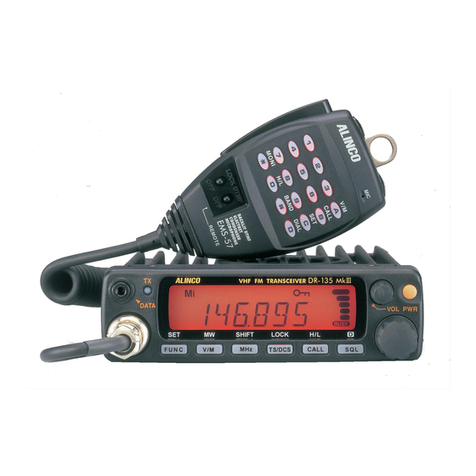
Alinco
Alinco DR-135 User manual

Alinco
Alinco DR-430 User manual

Alinco
Alinco DJ-V57T User manual

Alinco
Alinco DJ-140 User manual

Alinco
Alinco DR-570T User manual
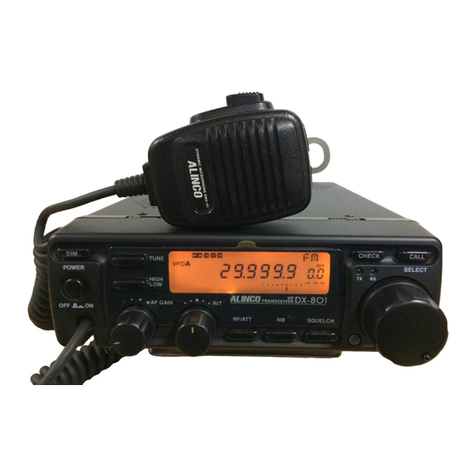
Alinco
Alinco DX-801 User manual

Alinco
Alinco DJ-V5T/E User manual

Alinco
Alinco DJ-C5 User manual

Alinco
Alinco DJ-W100 User manual

Alinco
Alinco DJ-G29T User manual
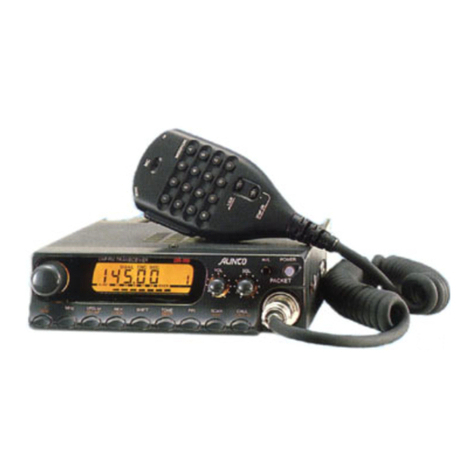
Alinco
Alinco DR-119T User manual

Alinco
Alinco DX-77 User manual
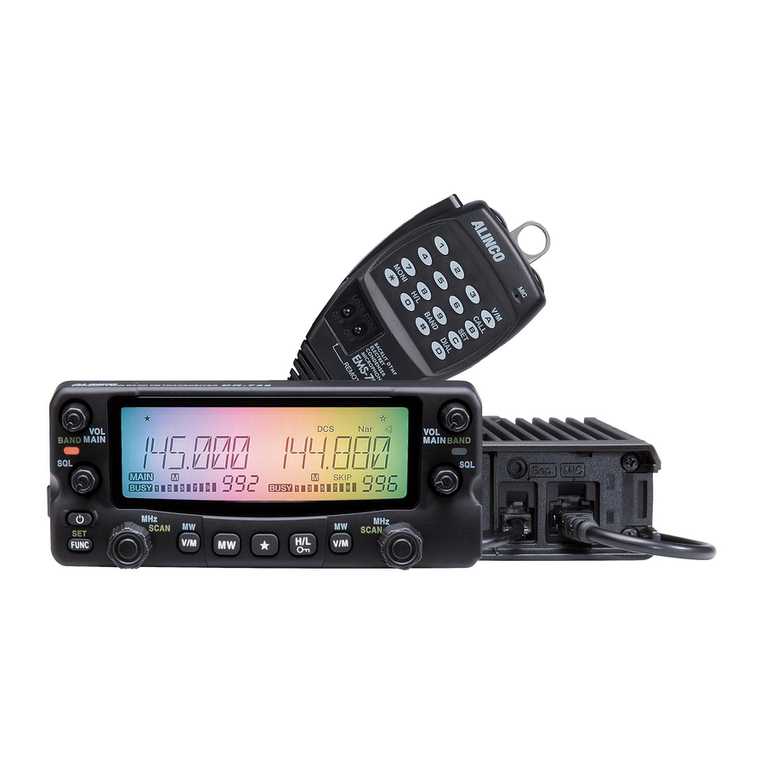
Alinco
Alinco DR-735T(2) User manual

Alinco
Alinco DR-638 User manual
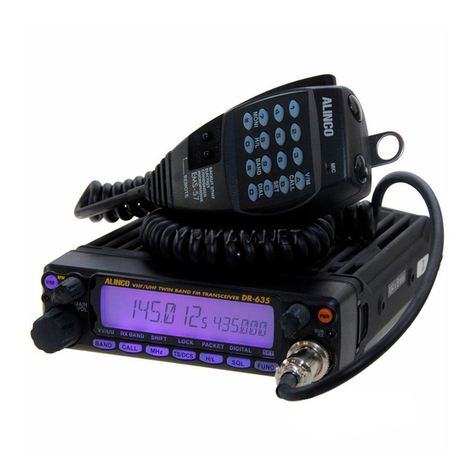
Alinco
Alinco DR-635T User manual
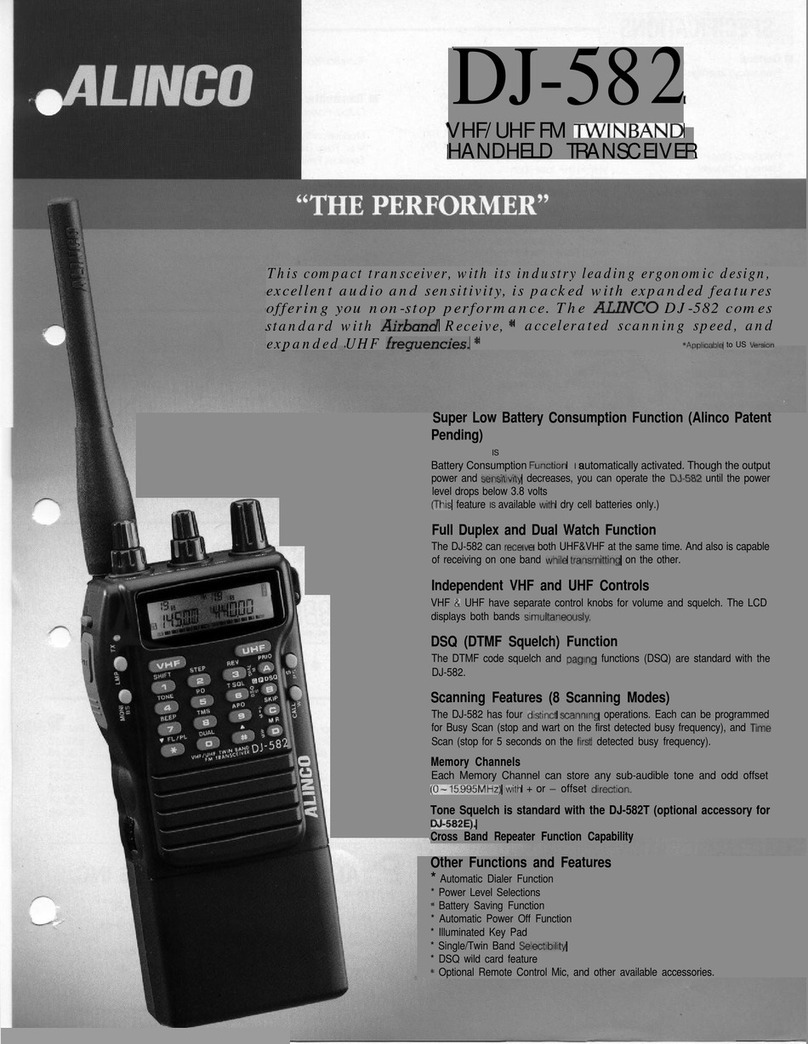
Alinco
Alinco DJ-582 User manual

Alinco
Alinco DJ-S446 User manual
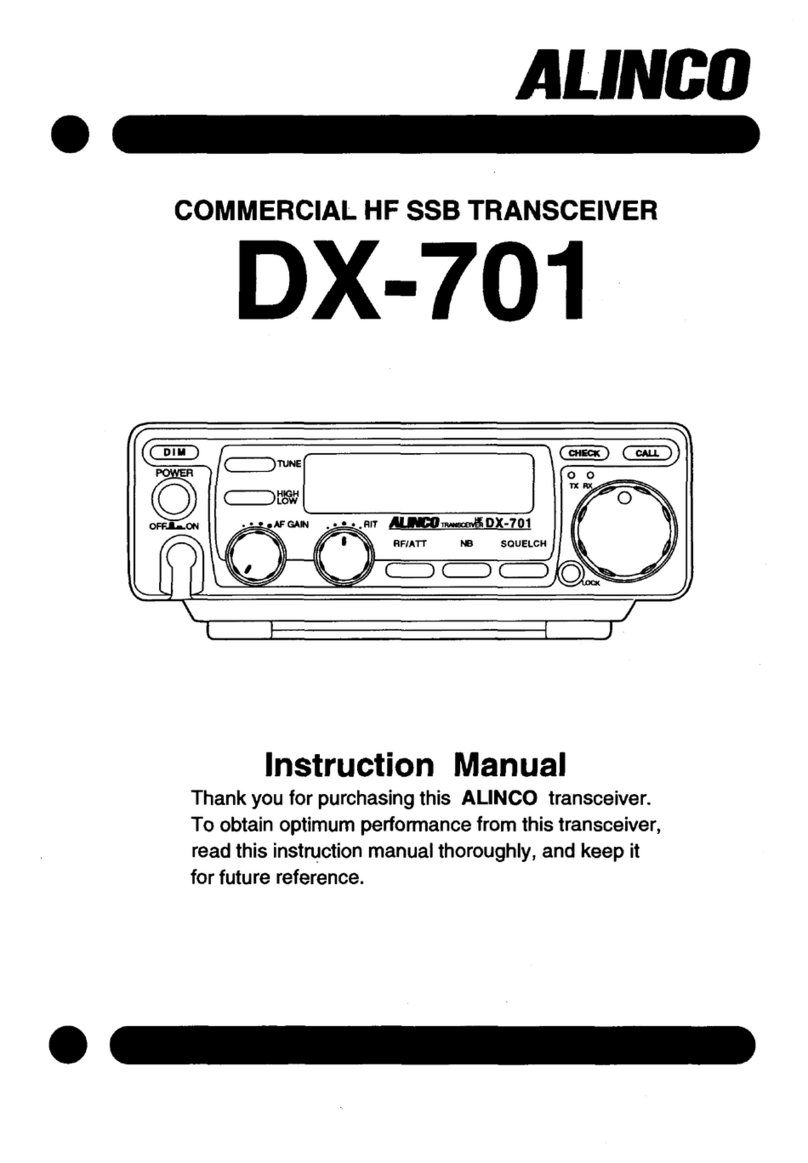
Alinco
Alinco DX-701 User manual
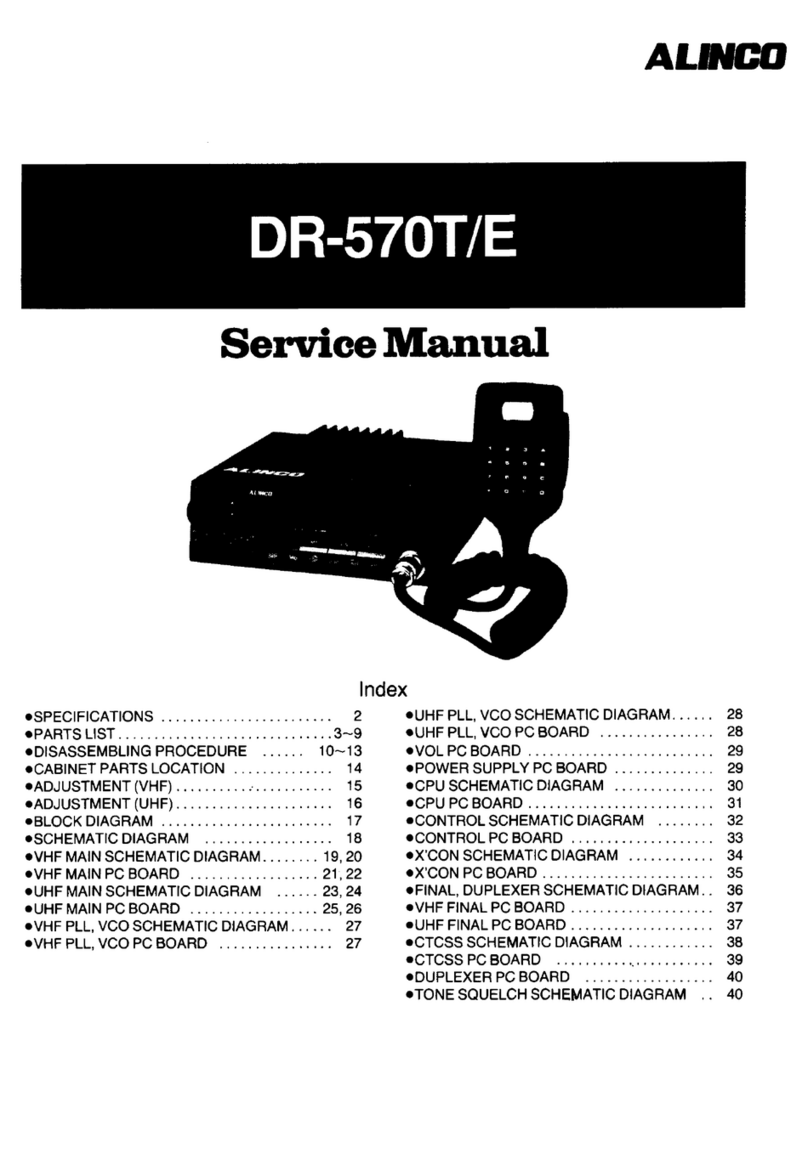
Alinco
Alinco DR-570T/E User manual

